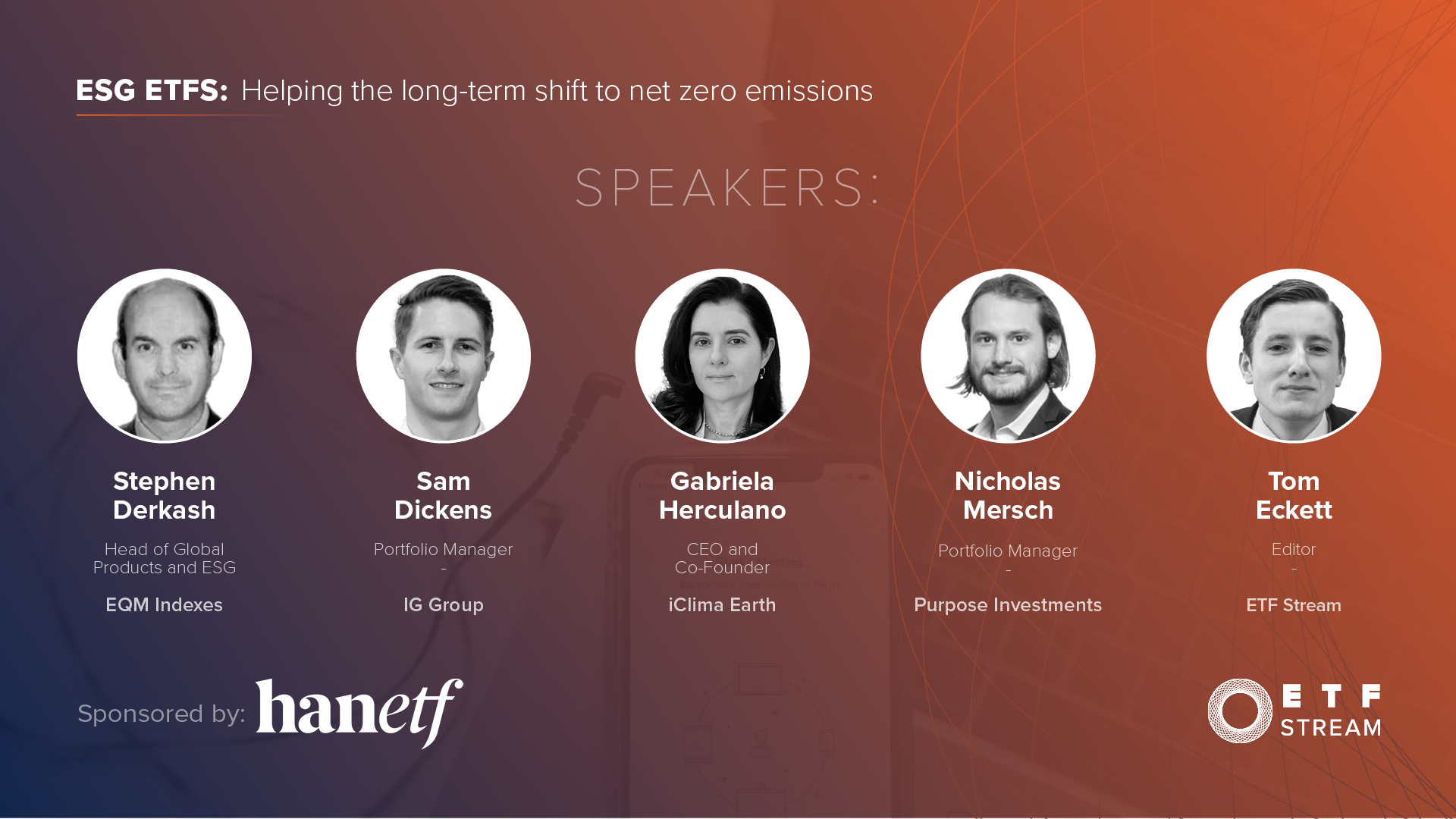The reasons behind rapid ESG ETF uptake, using thematics for direct exposure to the energy transition and the challenges of reducing carbon emissions were all discussed at ETF Stream’swebinar on ESG ETFs.
The webinar, titledESG ETFs: Helping the long-term shift to net zero emissions, started by examining the causes behind environmental, social and governance (ESG) investments moving into focus over the last couple of years.
According to data from Bloomberg Intelligence, ESG ETFs in Europe account for 40% of the $109bn inflows so far this year while also outpacing non-ESG ETF flows in 2020.
ESG gathering speed
Alongside European interest in climate issues, Gabriella Herculano, CEO and founder of iClima Earth, said the product class’s maturity has contributed to record flows, with the best strategies providing a clear purpose or goal; clarity in their negative screenings and exclusions – should they apply them; clear metrics, such as an ESG scorecard; and often a holistic approach that also values the ‘S’ and ‘G’ components.
Stephen Derkash, head of global products and ESG at EQM Indexes, added regulation is driving capital flows into more sustainable products.
“European regulators are aiming to reorient capital towards sustainable activities aligned to the EU goal of net zero of emissions by 2050,” Derkash said. “Especially in financial services, this means everybody will have to embed ESG into their process in some way.”
Investing in emissions reduction: A 2050 view
Another factor Durkash highlighted is the power of media uptake, with increased coverage of climate issues such as the Australian wildfires and droughts in California, alongside social issues such as Black Lives Matter and #MeToo.
Sam Dickens, portfolio manager at IG Group, then said increased retail involvement has played an important role. In addition to pressuring pension funds to move into investments aligning with ESG standards, private investors have found the sustainability story a compelling driver during their asset allocation.
“Because they are self-directed they can be quite slow to react,” Dickens continued. “But over the last 12 months we have seen really strong growth in the use of these products on our platform, by as much as five times over the last year.”
Thematic impact
However, while discussing broad uptake of ESG products, Dickens noted thematic strategies with a specific and defined focus on sectors such as clean energy and battery technology tended to resonate better with retail investors, given their clear investment narratives.
Nicholas Mersch, portfolio manager at Purpose Investments, said ESG screens serve an important purpose but only thematic strategies are able to directly target the trailblazers in decarbonisation.
Herculano added: “There is still confusion around what is net zero. We want to represent climate change in a different light, where we focus on companies whose revenues are in line with decarbonisation rather than those trying to reduce their own carbon emissions.
“The best way to reduce carbon in the atmosphere is to not emit it at all.”
Thematic ETFs play a crucial role in offering investors an easy-to-understand way to invest directly in energy transition frontrunners – and crucially – funnel money into the innovative small and mid-caps that need capital to innovate and may otherwise have been ignored by less niche ETFs.
One sector benefiting from rapidly growing popularity among investors is solar power, which has also been buoyed by the arrival of products such as Europe’s first pure-play solar ETF, the Solar Energy UCITS ETF (TANN).
Currently the cheapest form of new energy available, the solar power industry is expected to receive $4trn of funding associated with net zero pledges by 2050.
“The expectation out there is that solar will be the fastest-growing power source over the next couple of decades,” said Derkas, whose firm created the index tracked by TANN.
Combatting carbon
On the other side of the coin, investors are also looking at ways of reducing carbon emissions while the structural shift in our energy mix is taking place.
One way this has been done is by using carbon credits. Infamously, Tesla has been called out for owing much of its recent profit-making to these credits – though making this market tradeable also allows investors to speculate on carbon credits alongside the companies who need them for their operations (or balance sheets).
Mersch said: “What we need to do is tilt the unit economics in favour of making the right financial decision on top of making the right decision for the planet and that’s where carbon credits come in.”
Rather than speculation having a negative effect, Mersch said by investing in carbon credits, participants will increase their value, thus effectively levying a higher ‘carbon tax’ on high-polluting companies.
However, Mersch did note additional costs are likely to be passed onto employees and the end of consumer – not to mention high-polluting companies require capital to reduce their emissions.
Another important facet is data and transparency, with Herculano adding investors may have to wait some time for further advancements in data gathering and better taxonomy – including data that separates companies’ ‘green’ and ‘brown’ revenues.
On a positive note, Europe recently welcomed its first ETF with a carbon offset mechanism, the HANetf Global Clean Energy Select HANzero UCITS ETF (ZERO), while the Engine No.1 Transform ETF (VOTE) launched in the US, with many hoping it represents a new paradigm for active engagement on ESG issues.
To watch the full webinar, click here.







